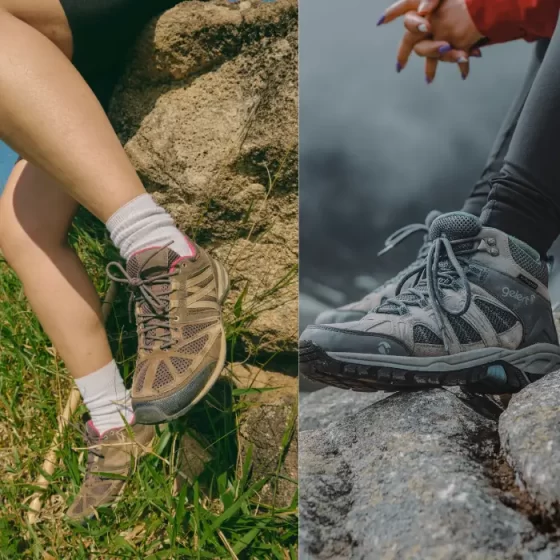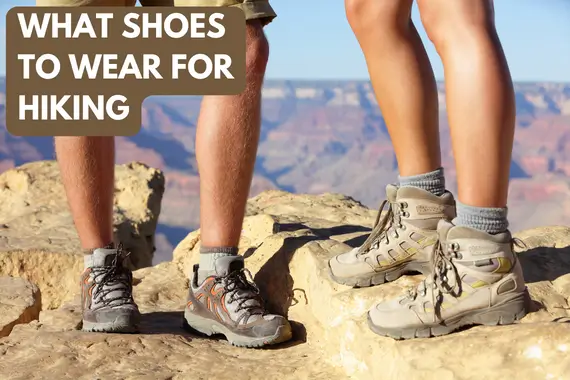
The search for the perfect hiking shoe is a mix of art, science, and a dash of environmental stewardship. This article ‘What Shoes to Wear for Hiking’ dishes out the secrets to making an informed choice, aiming to turn your outdoor exploits into comfy, safe, and earth-friendly adventures.
Understanding Different Types of Hiking Shoes
Step one: grasp the ABCs of hiking shoe materials. Let’s break it down—leather is your go-to for durability but carries weight. Synthetic? Light as a feather but don’t expect it to last forever. And rubber? Killer grip, but might steam your toes like a sauna.
Now, let’s throw in a plot twist: your shoes’ environmental footprint. Leather isn’t the eco-hero; think deforestation and pollution. Synthetics are petroleum guzzlers and a landfill’s forever friend. So, choosing the right hiking shoe isn’t just about your feet—it’s also a vote for or against Planet Earth. For more insights on eco-friendly hiking gear, check out American Hiking Society’s guide on hiking gear.
Key Takeaways
- Leather: Durable but heavy
- Synthetic: Light but less durable
- Rubber: Excellent grip but may lack breathability
- Your shoe choice = Your ecological vote
Checking the Quality and Durability of Hiking Shoes
Here’s the deal: longevity equals value for money and safety on trails. Enter Shoe Lifespan Evaluation, your tool for decoding a shoe’s expiration date.
So, how do you judge a shoe by its cover—or rather, its components? Three words: material analysis techniques. These sleuths scrutinize the what, the how, and the durability of your potential purchase.
| Shoe Components | What They Do | Durability Checkpoints |
|---|---|---|
| Upper Material | Shields against nature | Wear and tear, breathability |
| Midsole Material | Your personal cushion | Shape retention |
| Outsole Material | Ground contact | Traction, erosion speed |
The Role of Weather and Terrain in Choosing Hiking Shoes
Mother Nature is a drama queen; she loves switching between stormy and sunny. Your shoes need to keep up. From waterproof troopers to airy wanderers, your kicks should match the climate’s mood swings.
And don’t forget the terrain. Think Rocky Trails is going to play nice with your casual sneakers? Think again! Here’s a quick cheat sheet:
| Seasonal Footwear | Climatic Suitability | Terrain Compatibility |
|---|---|---|
| Waterproof Boots | Rainy/Snowy | Muddy/Wet |
| Breathable Boots | Hot/Dry | Desert/Dry |
| Sturdy-soled Shoes | Any Climate | Rough/Rocky |
Hiking Shoes: Comfort Vs. Functionality
It’s a tango between looking good and feeling good. On one hand, a slick design boosts your hiking morale. On the other, a custom fit can make your feet sing in comfort.
The Balancing Act
- Aesthetics: Keep it stylish but not at the cost of function.
- Custom Fit: Tailored = Comfortable, hence increased stamina.
- The Final Tradeoff: Comfort eases the hike; functionality makes it safe.
Proper Maintenance and Care for Your Hiking Shoes
A well-loved shoe is a long-lasting shoe. Brush off the dirt, wash ’em right, and dry like a pro (read: no direct heat). Consider waterproof sprays your shoe’s best friend, but don’t go overboard—too much can hurt.
And the red flags for the retirement party? Slipping grip, leaking water, and a cushion that’s given up on life.
Signs It’s Time for New Shoes
- Failing grip
- Water seeping in
- Lost cushion bounce
Conclusion
In a nutshell, choosing hiking shoes is a balancing act on a tightrope of comfort, functionality, and ethical choices. It’s like being a contestant on “Survivor,” where making the wrong alliance—or in this case, the wrong shoe choice—can lead to your downfall. Invest wisely, maintain religiously, and let your shoes take you places—both literally and metaphorically.

Hello, fashionistas and shoe lovers! I’m Sophia Stiletto, your go-to gal for all things footwear and fashion. Born and raised in New York City, the fashion capital of the world, I’ve been immersed in style from a young age. At 34, I’ve spent over a decade in the fashion industry, working with top designers and brands. My passion? Helping you find the perfect pair of shoes for any occasion!

